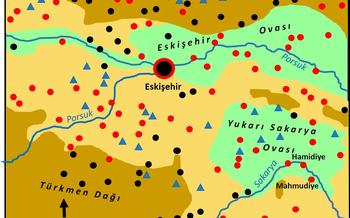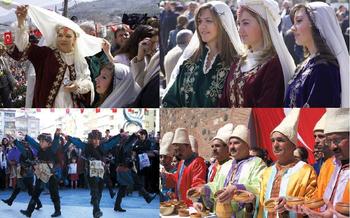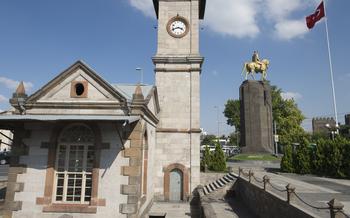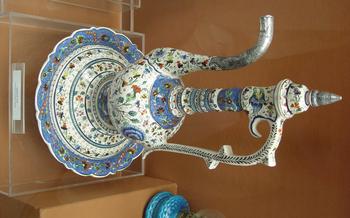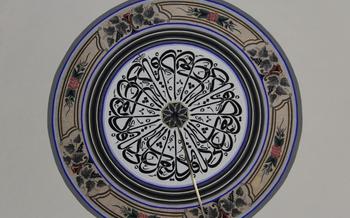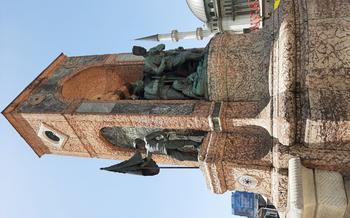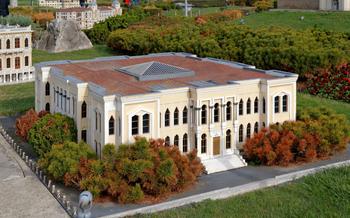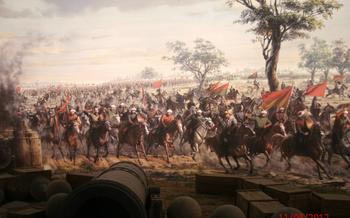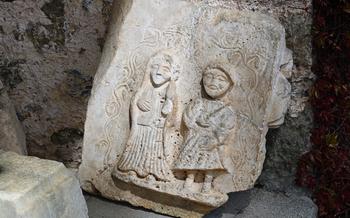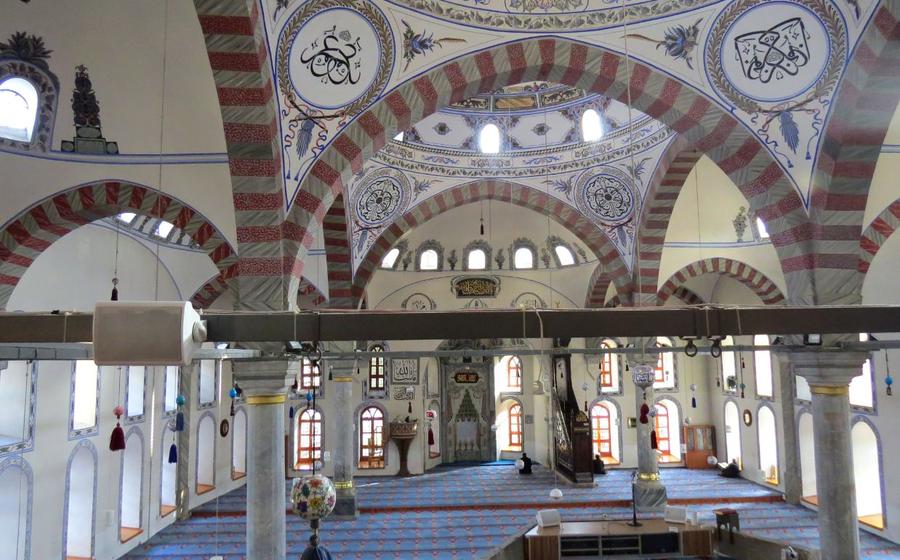
Kütahya Ethnography Museum
- Kütahya Ethnography Museum: A Journey into Turkish Culture
- Explore the Diverse Collection
- Discover the Art of Kütahya Tiles
- Immerse Yourself in Village Life
- Learn about Local Craftsmanship
- Witness Traditional Performances
- Unearth Archaeological Treasures
- Delve into Local Cuisine
- Engage with Interactive Exhibits
- Immerse Yourself in History
- Witness the Evolution of Lifestyle
- Connect with Local Artisans
- Discover Hidden Gems Within the Museum
Kütahya Ethnography Museum: A Journey into Turkish Culture
Housed in a beautifully restored 19th-century building, the Kütahya Ethnography Museum is a treasure trove of Turkish culture and heritage. Its collection of artifacts, exhibits, and interactive displays offers visitors a fascinating glimpse into the region's rich history, traditions, and way of life.
Established in 1968, the museum plays a pivotal role in preserving and promoting the cultural heritage of Kütahya. It is strategically located in the heart of the city, making it easily accessible to both local and international visitors. The museum's focus on cultural tourism aligns perfectly with the growing global interest in authentic and immersive travel experiences.
Architecturally, the museum blends traditional and modern elements, creating a unique and welcoming space for visitors. Its spacious galleries, adorned with intricate tilework and decorative motifs, provide a fitting backdrop for the diverse collection of exhibits. Visitors are immediately drawn to the museum's inviting atmosphere, which sets the stage for an enriching and educational journey into Turkish culture.
Explore the Diverse Collection
The Kütahya Ethnography Museum boasts a vast and diverse collection of artifacts and exhibits, providing visitors with a comprehensive insight into the rich cultural heritage of the region. From intricately handcrafted textiles and traditional clothing to pottery, metalwork, and woodworking, the museum showcases the skills and artistry of local artisans. Each exhibit tells a story, offering a glimpse into the daily life and customs of the people of Kütahya.
The museum's collection is particularly renowned for its collection of handicrafts, which includes intricate embroidery, delicate lacework, and colorful rugs. These pieces showcase the exceptional craftsmanship and creativity of local artisans, who have passed down their skills and techniques from generation to generation. Visitors can admire the intricate patterns, vibrant colors, and meticulous attention to detail that characterize these traditional crafts.
Traditional clothing is another highlight of the museum's collection, offering a glimpse into the diverse cultural influences that have shaped the region. Visitors can see examples of traditional Turkish costumes, as well as garments that reflect the unique customs and traditions of Kütahya. From elaborately embroidered dresses to colorful headscarves, these garments provide a fascinating insight into the region's rich textile heritage.
The museum's exhibits also provide a window into the daily life and customs of the people of Kütahya. Visitors can learn about traditional farming practices, household chores, and social customs through a variety of interactive displays and life-size dioramas. These exhibits recreate scenes from everyday life, allowing visitors to experience the sights, sounds, and smells of a bygone era.
The Kütahya Ethnography Museum's collection is not only a testament to the region's rich cultural heritage but also a valuable resource for researchers and scholars. The museum's artifacts and exhibits provide a wealth of information about the history, traditions, and customs of the people of Kütahya, making it an essential destination for anyone interested in Turkish culture.
Discover the Art of Kütahya Tiles
Kütahya is renowned for its exquisite tile-making tradition, and the Kütahya Ethnography Museum showcases this art form in all its glory. Visitors can marvel at the intricate designs, vibrant colors, and exceptional craftsmanship of these tiles. From traditional geometric patterns to elaborate floral motifs, the tiles on display represent the diverse range of styles and techniques that have made Kütahya a center of tile-making excellence.
The museum houses a comprehensive collection of tiles from different periods, allowing visitors to trace the evolution of tile designs and techniques. From the early Seljuk period to the Ottoman era, each tile tells a story of the region's rich artistic heritage. Visitors can admire the intricate cuerda seca technique, which involves painting on glazed tiles before firing, as well as the stunning lusterware tiles that shimmer with a metallic sheen.
The Kütahya Ethnography Museum is a treasure trove for anyone interested in the art of tile-making. Whether you are an art enthusiast, a designer, or simply someone who appreciates beauty, you will be captivated by the stunning collection of Kütahya tiles. Take your time to explore the different exhibits, and you will come away with a newfound appreciation for this remarkable art form.
Immerse Yourself in Village Life
Within the walls of the Kütahya Ethnography Museum, visitors are transported to a bygone era, where traditional village life unfolds before their eyes. Life-like displays of rural homes, workshops, and farms recreate the ambiance of a vibrant village community, offering a glimpse into the lifestyle and occupations of villagers.
Through these exhibits, visitors can witness the simplicity and charm of village life, where daily tasks and routines were closely intertwined with nature and tradition. The museum showcases the tools, implements, and techniques used by villagers to cultivate crops, raise livestock, and create handcrafted goods.
By immersing themselves in this recreated village setting, visitors gain a deeper understanding of the challenges and rewards of rural life, the importance of preserving traditional skills and customs, and the enduring connection between people and the land. The museum serves as a testament to the resilience and resourcefulness of village communities throughout history.
Learn about Local Craftsmanship
The Kütahya Ethnography Museum provides a unique opportunity to witness the skills and techniques of local artisans firsthand. Demonstrations of traditional crafts like pottery, weaving, and metalworking are held regularly, allowing visitors to observe the intricate processes involved in creating these beautiful objects. Visitors can also participate in workshops and interactive experiences, trying their hand at these traditional crafts themselves. This is an excellent way to learn about the skills and techniques used by artisans and to gain an appreciation for the value of handmade goods. Supporting local craftsmanship is essential for preserving these traditional skills and ensuring that they continue to be passed down to future generations.
Witness Traditional Performances
Enrich your visit to the Kütahya Ethnography Museum by immersing yourself in the vibrant performing arts of the region. Regular demonstrations of folk dances, music, and storytelling bring the museum to life, showcasing the rich cultural heritage of Kütahya.
Witness the graceful movements of traditional folk dances, accompanied by rhythmic music and melodious songs. These performances provide a glimpse into the local customs and traditions, offering a unique perspective on the region's cultural identity.
Storytelling sessions transport visitors to a world of fables, legends, and historical tales, preserving the oral traditions that have been passed down through generations. These captivating narratives offer insights into the values, beliefs, and experiences of the local people.
Attending these performances is not just a form of entertainment but also an opportunity to connect with the living culture of Kütahya. By witnessing these traditional arts, you contribute to their preservation and promotion, ensuring that they continue to thrive for generations to come.
Join the audience and let the rhythms, melodies, and stories of Kütahya captivate your senses, creating lasting memories of your journey into Turkish culture.
Unearth Archaeological Treasures
The Kütahya Ethnography Museum is not only a repository of cultural artifacts but also a treasure trove of archaeological discoveries. Excavations conducted in Kütahya and the surrounding region have yielded a wealth of ancient artifacts that shed light on the region's rich history and diverse civilizations.
Visitors to the museum can marvel at a captivating array of archaeological treasures, including ancient coins, pottery, and tools. These artifacts provide valuable insights into the lives and customs of past civilizations that once flourished in this region. The museum's collection includes coins from various historical periods, offering a glimpse into the economic and political systems of the past.
The pottery on display showcases the artistry and craftsmanship of ancient potters, revealing intricate designs and motifs that speak to their cultural influences. Tools and implements provide further evidence of the technological advancements and daily activities of these ancient societies.
By preserving and displaying these archaeological treasures, the Kütahya Ethnography Museum plays a crucial role in safeguarding the region's cultural heritage and educating visitors about the rich tapestry of civilizations that have shaped its history.
Delve into Local Cuisine
Gastronomy enthusiasts will delight in the museum's exploration of Kütahya's culinary heritage. Traditional Turkish dishes and regional specialties are showcased, providing a glimpse into the flavors and aromas that define this vibrant region. Visitors can learn about the unique ingredients, cooking techniques, and culinary traditions that have shaped Kütahya's cuisine over centuries.
The museum's exhibits showcase mouthwatering displays of local delicacies, from savory kebabs and gözleme to sweet pastries and desserts. Interactive exhibits allow visitors to virtually taste and experience the diverse flavors of Kütahya's cuisine. Cooking demonstrations and workshops provide an opportunity to learn from local chefs and try your hand at preparing some of the region's signature dishes.
By immersing yourself in the culinary traditions of Kütahya, you'll gain a deeper appreciation for the region's rich cultural heritage. The museum's exploration of local cuisine not only satisfies your taste buds but also provides a deeper understanding of the social and cultural factors that have shaped the region's culinary identity.
So, while you're exploring the Kütahya Ethnography Museum, be sure to take a break and indulge in the delectable flavors of local cuisine. Whether you're savoring a traditional Turkish coffee or sampling the region's renowned gözleme, you'll create lasting memories and a newfound appreciation for the culinary delights of Kütahya.
Engage with Interactive Exhibits
The Kütahya Ethnography Museum offers a variety of interactive exhibits that allow visitors to engage with Turkish culture in a fun and engaging way. These exhibits are designed to provide a hands-on experience that helps visitors understand and appreciate the rich cultural heritage of the region.
One popular exhibit is a traditional Turkish kitchen, where visitors can learn about the culinary traditions of Kütahya and try their hand at cooking some local dishes. Another exhibit showcases traditional Turkish handicrafts, such as pottery, weaving, and embroidery, and allows visitors to try their hand at these skills under the guidance of experienced artisans.
Interactive multimedia displays provide visitors with in-depth information about various aspects of Turkish culture, including history, music, and dance. These displays often feature videos, touchscreens, and interactive games that make learning about Turkish culture fun and engaging for visitors of all ages.
The importance of interactive exhibits in museums cannot be overstated. They make museums more accessible and engaging to visitors, especially younger audiences who may have shorter attention spans. By providing hands-on experiences and multimedia displays, the Kütahya Ethnography Museum creates a dynamic and interactive learning environment that encourages visitors to explore and discover the rich cultural heritage of Kütahya.
Immerse Yourself in History
The Kütahya Ethnography Museum is a treasure trove of historical artifacts and documents that provide a glimpse into Kütahya's rich past. From ancient coins and pottery to historical documents and photographs, the museum offers a comprehensive overview of the region's role in major historical events.
One of the most fascinating exhibits is a collection of artifacts from the Ottoman period, showcasing the region's significance during this time. Visitors can admire intricate calligraphy, ornate jewelry, and traditional clothing, gaining insights into the daily lives and customs of the Ottoman era.
Another highlight is the section dedicated to the Turkish War of Independence, showcasing the region's contributions to the struggle for independence. Visitors can learn about the heroic efforts of local leaders and witness the hardships faced by the people of Kütahya during this tumultuous period.
Through these historical exhibits, the Kütahya Ethnography Museum not only preserves the region's past but also inspires visitors to learn from history and appreciate the sacrifices made by previous generations.
Witness the Evolution of Lifestyle
The Kütahya Ethnography Museum offers a fascinating glimpse into the evolution of lifestyle in the region. Through a series of exhibits, visitors can trace the changes in daily life and customs over time, gaining insight into the social, economic, and cultural transformations that have shaped the region.
Exhibits showcase the transition from traditional rural lifestyles to more modern urban ways of life, highlighting changes in housing, transportation, fashion, and technology. Visitors can see how the introduction of new technologies and industries has impacted the lives of local people, and how globalization has influenced cultural practices.
By exploring these changes, the museum helps visitors understand the forces that have shaped contemporary Turkish society and appreciate the diversity of lifestyles that exist within the country. It also highlights the importance of preserving traditional practices and cultural heritage in the face of modernization.
Through interactive displays and multimedia presentations, the museum encourages visitors to compare past and present ways of life, reflecting on how societal norms, values, and traditions have evolved over time. This journey through history offers a deeper understanding of the region's rich cultural heritage and the resilience of its people.
Connect with Local Artisans
The Kütahya Ethnography Museum offers a unique opportunity to connect with and learn from local artisans. These skilled craftsmen and women demonstrate their traditional crafts, such as pottery, weaving, and carpet making, right within the museum. Visitors can observe their intricate techniques, ask questions, and even try their hand at some of the crafts themselves. This firsthand interaction provides a deeper understanding of the skills, dedication, and passion that go into creating these beautiful handmade items.
Engaging with local artisans is not only an enriching experience but also a way to support their livelihoods and preserve these traditional crafts. By purchasing their handmade products, visitors directly contribute to the continuation of these centuries-old traditions. The museum provides a platform for artisans to showcase their work, connect with potential customers, and pass on their knowledge to future generations.
One of the highlights of the museum is the pottery workshop, where visitors can witness the transformation of clay into exquisite ceramic pieces. The potters skillfully shape and decorate each item, using techniques that have been passed down for generations. Visitors can observe the entire process, from the initial molding of the clay to the final firing and glazing. They can also try their hand at pottery, creating their own unique pieces under the guidance of experienced artisans.
The museum also features a weaving workshop, where visitors can learn about the intricate art of Turkish carpet making. Artisans demonstrate the traditional techniques of knotting and dyeing, creating vibrant and colorful carpets that are both functional and decorative. Visitors can admire the intricate patterns and designs, which often tell stories or depict scenes from nature. They can also try their hand at weaving, creating their own small textile pieces using traditional looms.
These interactive experiences with local artisans provide a deeper appreciation for the skill, creativity, and cultural significance of traditional crafts. Visitors leave the museum with a newfound respect for the artisans and a greater understanding of the importance of preserving these valuable traditions.
Discover Hidden Gems Within the Museum
Beyond the renowned exhibits, the Kütahya Ethnography Museum holds a treasure trove of hidden gems waiting to be discovered. These lesser-known artifacts and displays offer a unique glimpse into the diverse and intricate cultural heritage of the region.
One such gem is a collection of antique jewelry, showcasing the exquisite craftsmanship and intricate designs that were once commonplace in Kütahya. From delicate filigree earrings to ornate necklaces adorned with precious stones, these pieces provide a glimpse into the personal adornments and traditions of the past.
Another hidden treasure is a series of photographs depicting daily life in Kütahya from the early 20th century. These images capture the essence of a bygone era, showcasing traditional dress, occupations, and social interactions. Through these photographs, visitors can gain a deeper understanding of the rhythms and routines that shaped Kütahya's communities.
For those interested in religious history, the museum houses a collection of rare manuscripts and illuminated Qur'ans. These beautifully crafted books offer insights into the region's Islamic heritage and the artistry associated with religious texts.
Discovering these hidden gems within the Kütahya Ethnography Museum is like embarking on a treasure hunt, revealing the untold stories and diverse expressions of a rich cultural tapestry. These lesser-known exhibits invite visitors to delve deeper into the museum's collection and gain a more comprehensive appreciation for the region's unique and multifaceted history.
